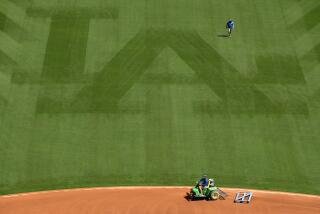Poetry in Motion
Poetic license aside, can sports and poetry really coexist? Absolutely, says Cal State Northridge creative writing lecturer Noah Blaustein, editor of “Motion: American Sports Poems” (University of Iowa Press). From baseball to bullfighting, more than 30 sports are covered in poems by literary luminaries such as James Tate, Gary Soto, Christopher Merrill, Marianne Moore, Quincy Troupe and Sherman Alexie. Born and raised in Pacific Palisades, Blaustein, 32, grew up “playing everything.” When not teaching or writing, he surfs every chance he gets, “from Venice to Zuma.”
Which came first, your love of sports or your love of poetry?
It’s a great misconception that you can’t have both. In L.A., you can exercise 320 days of the year [but you can also] read a book. I didn’t start writing poetry until later, but words were always alive in our house. My father [UCLA Extension art instructor Joe Blaustein] was always reading, as were my brother and sister. On the other hand, I don’t think anyone can avoid sports. It’s pervasive throughout society, both as an activity and as mega-corporate entertainment.
Would the Bard of Avon approve of sports poems?
James Dickey once said: “Shakespeare never did any pole-vaulting.” But we evolve. Shakespeare didn’t know about surfing, but now there’s a surf contest in Cornwall, England. Who knows? Maybe the Shakespeare of our generation surfs.
How does poetry capture the rhythm of sports?
Because of its immediacy, poetry puts you inside the facts. It puts emotion to numbers. In sports, you’re constantly trying to re-create these heightened moments. A good poem, by its very nature, has a way of locking that in permanently. You can return to it, see what you saw the first time with the same amount of power, and then see it differently, again and again. Was there a sport you couldn’t find a poem about?
After the book came out, Dorothy Barresi--whose work appears in “Motion”--did a cockfighting poem. But it was too late. I didn’t go after certain sports, except I did try to limit the number of baseball poems. But, really, the question is about the ability of the poet. The poet has to be able to make it work, no matter the sport.
You didn’t include “Casey at the Bat.” Why not?
“Casey at the Bat” is overemphasized. It’s not a very good poem.
More to Read
Sign up for our Book Club newsletter
Get the latest news, events and more from the Los Angeles Times Book Club, and help us get L.A. reading and talking.
You may occasionally receive promotional content from the Los Angeles Times.








